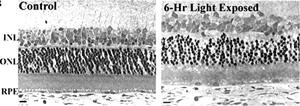US scientists have in vivo evidence that sunlight could be one of the factors leading to age-related macular degeneration (AMD) which is the principal cause of blindness in the elderly.
The etiology of AMD is often associated with aging, smoking, a high-fat diet, genetics and gender. There have also been several debates about whether sunlight is an environmental factor causing AMD, however previous studies have failed to confirm this relationship.
In the study published in Photochemical & Photobiological Sciences, Wielgus et al. showed that blue light exposure promotes the oxidation of A2E and iso-A2E in the rats’ eyes leading to phototoxicity in the retinal cells. A2E is a functional group present in lipofuscin, a fluorescent material which demonstrates the first signs of macular degeneration in the retinal cells. When one gets older, the level of A2E, a bis-retinaldehyde-phosphatidylethanolamine, increases in the retinal cells.
-

Cross section images of the retinas isolated from the rats exposed to blue light or housed in the dark for 6 h. The retinas were evaluated immediately after light exposure. Pyknotic nuclei in the ONL and disorganization of photoreceptor inner and outer segments were the earliest retinal changes that were observed.
The exact structure(s) of photo-oxidised A2E have yet to be determined but they were found to cause extensive damage to the retina. This study suggests that a similar effect may also be taking place in human eyes.
Read the article online:
Blue light induced A2E oxidation in rat eyes – experimental animal model of dry AMD
A. R. Wielgus, R. J. Collier, E. Martin, F. B. Lih, K. B. Tomer, C. F. Chignell and J. E. Roberts, Photochem. Photobiol. Sci., 2010, DOI:10.1039/c0pp00133c










